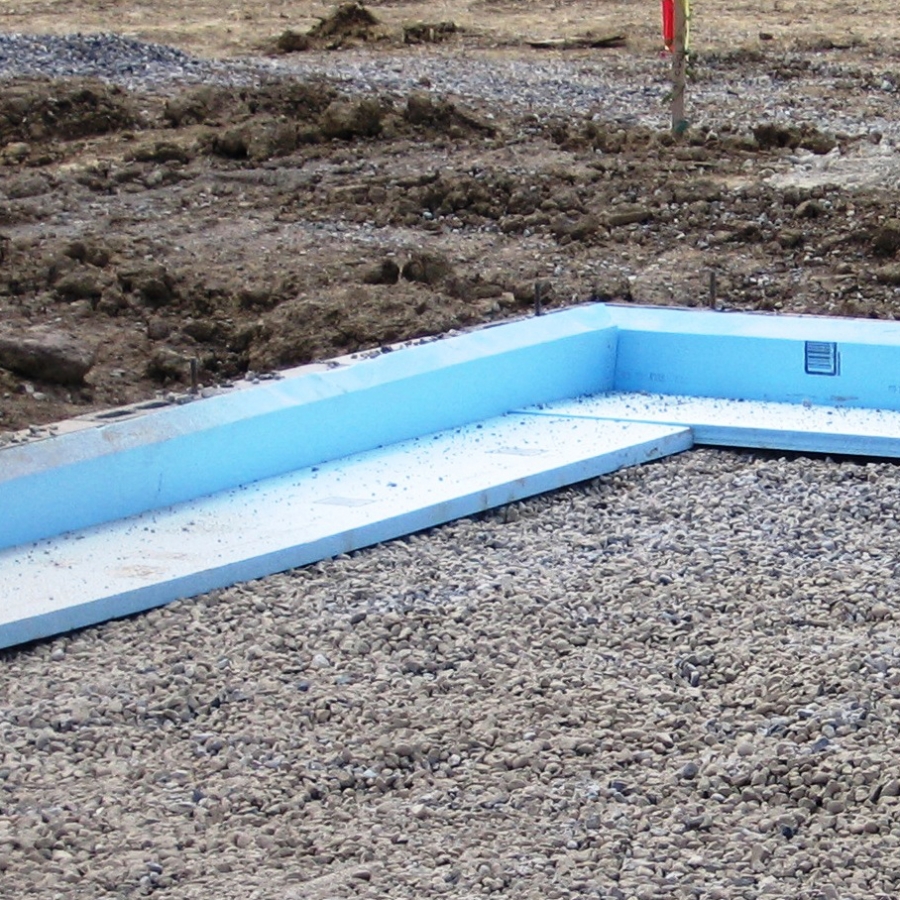Slab-On-Grade Foundation Insulation
Properly insulating your slab-on-grade floors not only will help you save on energy bills, but also will improve your home's comfort. Cold concrete slabs can be a source of discomfort in a home. An insulated slab reduces heat loss, making it easier to heat. This reduction in heat loss helps moderate indoor temperatures.

Topic Summary
Annual Energy Savings and Payback
Slabs lose energy primarily as a result of heat conducted outward and through the perimeter of the slab. Therefore, in most parts of the United States, insulating the exterior edge of the slab can reduce heating bills by 10%–20%. In climates with mild winters, slab insulation in a typical 1,800 square-foot home would save $50–$60 annually. Slab insulation with an R-value of R-10 for an 1,800 square-foot home typically could cost $300–$600 to install. Thus, the insulation would pay for itself in 5 to 10 years.
The investment in slab insulation is also economical as part of a mortgage. An insulation cost of $450 would add about $38 to the annual mortgage. However, the insulation would save over $50 annually in energy bills. Therefore, the savings exceed the additional mortgage cost from the beginning, resulting in an immediate payback.
Determining Insulation R-Value and Depth
The International Energy Conservation Code Council (IECC) specifies both the R-value and minimum distance for the insulation from the top of the slab downward based on a locality's Heating Degree Days (HDDs). Consult your local weather bureau for your area's actual Heating Degree Days. Then use the table below to find the IECC's recommended depth and R-value based on your Heating Degree Days.
Table 1. Recommended R-Values and Depth for Slab Insulation |
||
| Heating Degree Days |
Feet Installed Vertically |
R-Value |
| 0 to 2,499 | none required | none required |
| 2,499 to 4,500 | 2 feet | R-4 |
| 4,500 to 6,000 | 4 feet | R-5 |
| 6,000 to 7,200 | 4 feet | R-6 |
| 7,200 to 8,700 | 4 feet | R-7 |
| 8,700 to 10,000 | 4 feet | R-8 |
| 10,000 to 12,400 | 4 feet | R-9 |
| 12,400 to 14,000 | 4 feet | R-10 |
Select and install insulation using these recommendations. Be sure to use only insulation approved for below-grade use.
Insulation Techniques

Slab insulation can be installed using one of two basic techniques:
- Installing rigid insulation, typically foam board, directly against the exterior of the slab and footing
- Building a "contained" or "floating" slab with interior rigid insulation, typically foam board.
If insulation is installed on the exterior of the slab:
- Install it from the top of the slab to the bottom of the frost line unless a termite inspection gap is required.
- Encapsulate or cover the exterior face of the insulation with a protective membrane to serve as a capillary break and to protect the insulation from termites.
- Cover the above-grade portion of the insulation exposed to the outside air using a stucco coating, pressure-treated wood, brick, or aluminum flashing. When covering insulation, be conscious of how to detect termites in areas prone to termite infestation. Some states in termite-prone areas address this issue by requiring a termite inspection gap near the top of the slab insulation.
Other Considerations
When installing a slab foundation and insulating it, it's also important to consider moisture and air leakage control, as well as termite control.
Termites can tunnel undetected through exterior slab insulation to gain access to the wood framing in a home's walls. As a result, some insurance companies won't guarantee homes with slab insulation against termites. Building codes in several southern U.S. states prohibit installing foam insulation in contact with the ground.
"Floating" slab foundations with interior insulation provide more termite resistance. However, some builders in the southeastern United States have reported termite infestations through foam insulation on contained slabs.
To help offset termite problems, follow these guidelines:
- Provide effective moisture control systems.
- Remove all wood from around the foundation before backfilling.
- Install termite shields continuously under the sill plate of the building. The shield should project beyond the sill plate and all other portions of the exterior wall. While not 100% effective, the termite shield may deter or delay widespread infestation. It may also force termites into an exposed area where they can be detected. A continuous layer of a membrane—such as rubberized roofing material used in commercial buildings—may be used as an alternative to the termite shield.
- Use a foam insulation treated with a termiticide. Usually a derivative of boric acid, the termiticide should pose no more threat to homeowners than traditional termite treatments.
You'll also want to regularly inspect for termites. If you use a pest control company, obtain a good warranty for its work.
Finally, you need to consider radon resistance or control when installing slab-on-grade foundations. See the Learn More resources on the right side of this page (or below if you've printed it out) for more information about radon and radon-resistant construction techniques.
Article source: The U.S. Department of Energy’s Office of Energy Efficiency and Renewable Energy (EERE). For the most up-to-date information please visit the EERE website.



